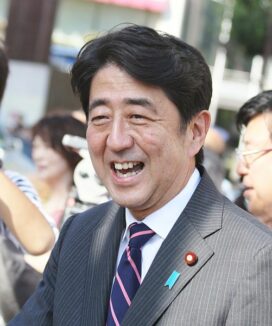Facts about Shinzo Abe
Shinzo Abe Biography
Shinzo Abe was Japan’s prime minister from 2006-07, and then again from 2012-2020. He was assassinated in 2022 while making a speech in Nara, Japan.
Shinzo Abe (pronounced “AH-bay”) was born to politics: his father and paternal grandfather were both high-ranking members of the Liberal Democratic Party (LDP), and his mother’s father was Nobusuki Kishi, Japan’s prime minister from 1957-60. Abe studied politics at Seikei University and the University of Southern California and went to work for Kobe Steel in 1979.
Abe soon entered government work, getting a leg up from his dad, Shintaro Abe. He was elected to the House of Representatives for the first of five times in 1993 and began moving up the party ranks.
Abe served as the deputy chief cabinet secretary for prime ministers Yoshiro Mori and Junichiro Koizumi from 2000-03, and made a name for himself when he stood up to North Korea’s Kim Jong Il over the North Korean abductions of Japanese nationals. In 2003, he became the secretary general for the LDP, the ruling party in Japan for most of the previous 50 years.
Shinzo Abe succeeded Koizumi as prime minister on 26 September 26, 2006. As prime minister, he advocated a strong national defense and firmer ties to the United States as a counterweight to future threats from China and North Korea.
However, he was weakened by a series of gaffes, financial scandals and accusations of cronyism, and made a surprise resignation announcement less than a year later, on September 12, 2007. He was succeeded as prime minister by another LDP member, Yasuo Fukuda.
In 2010, the center-left Democratic Party of Japan (DPJ) took power. But in 2012, Abe and the LDP made a comeback, winning power on a platform of increased federal spending and fiscal reform (called “Abenomics” by the local press) and a more aggressive attitude toward China.
Shinzo Abe was formally elected prime minister by the lower house of the Diet on December 26, 2012, replacing Yoshihiko Noda. In 2017 and 2018 his administration was rocked by scandals — allegations of favors for friends — and his popularity plummeted as critics called for him to resign.
Abe hung on, however, until 2020. Abe announced that he would before the end of his term, citing his life-threatening ailment, a chronic condition called ulcerative colitis. He stepped down on September 16, 2020, and was succeeded by Yoshihide Suga.
Shinzo Abe was shot to death in the city of Nabe, Japan on July 8, 2022. Abe had just begun a campaign speech in support of Councillor Kei Satō, a fellow member of the Liberal Democratic Party, when he was shot twice in the back. Abe was the only person shot, and he died before reaching a hospital. A 41-year-old man named Tetsuya Yamagami was arrested at the scene and charged with Abe’s murder.
Extra credit
Shinzo Abe’s official reason for resigning was a “chronic bowel ailment,” which he later said he had been able to control with medication… Shinzo Abe’s critics often accused him of being too nationalistic, and he raised eyebrows with his interpretation of World War II history, which questioned the validity of the Tokyo War Crimes Tribunal. Less than a month before becoming prime minister in 2006, Abe visited the Yasukuni Shrine, a memorial for Japanese soldiers that includes the graves of convicted war criminals. He pooh-poohed complaints from the Chinese and North Korean governments, and explained his visit as non-official and private.

